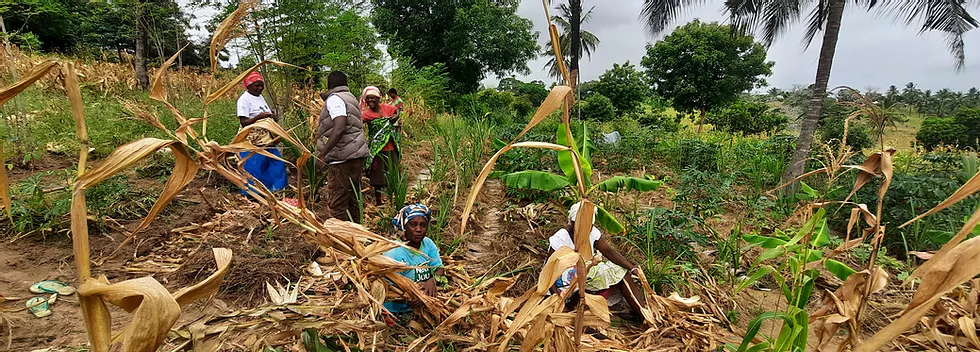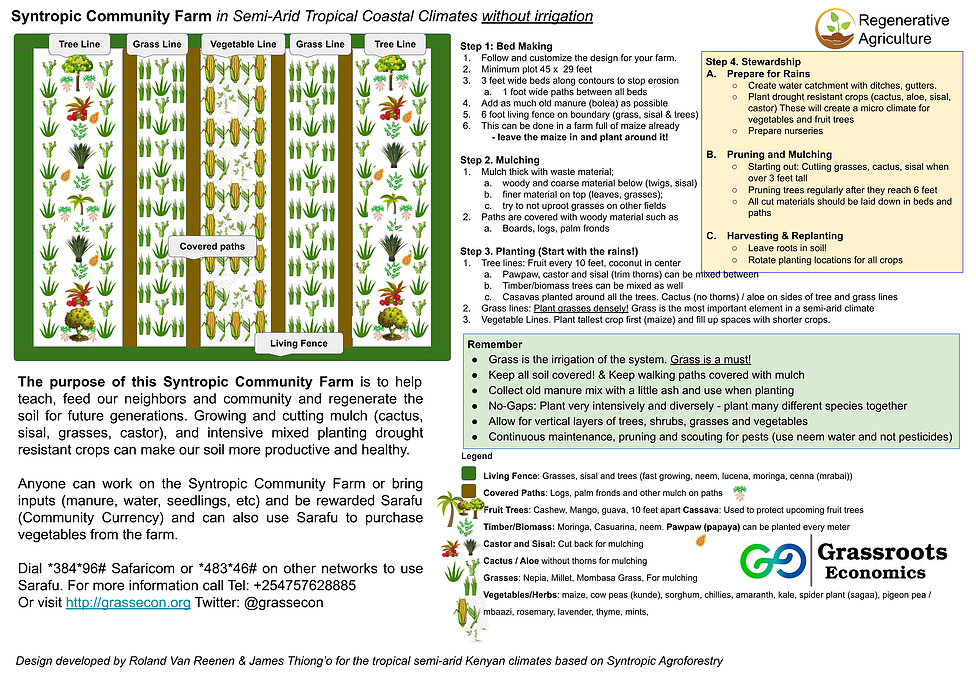
Food Forest Heritage - Vihunga
Having worked on a myriad farming techniques, we’ve never been more inspired by the practicality and theory behind Syntropic Agroforestry. Regenerating soil while practically providing crops and long term food forests is actually possible! Syntropic Agroforestry is amazing. It captures all the good of permaculture and organic farming and is easy for people to copy and put to use!
We’ve had the pleasure of hosting Roland van Reenen from Curacao, as well as James Thiong'o from Central Kenya and many other specialists. We are convinced that food forestry via Syntropic Agroforestry and regenerative organic agriculture programs will solve problems of food insecurity. The following farm schedule: has already been adapted and duplicated in hundreds of farms using traditioanl rotational labor practices.

Some core syntropic principals:
- Ensure Soil is covered: so that water and nutrients don’t evaporate and that roots and mycorrhizal fungi can absorb and move around those nutrients. (Don’t even step on bare soil).
- Maximize Photosynthesis: plants requiring different amounts of sunlight can be planted above, below and around each other to ensure that sunlight isn’t wasted on the soil and at least twice the amount of energy can be consumed by plants.
- Succession: Ensure that there is a clear succession of plants. E.g. As a cassava grows it can give shelter to a fruit tree.
- Stratification – Fill each layer of vegetation and maintain diversity for system health. Space (stratification) has to be harmonized over time (life cycle), respecting the successional steps within each of the systems
- Management – Keeping balance, reducing excess growth.
Using Community Asset Vouchers (CAV) to budget for the creation and maintenance of food forests seems as natural as the syntropic principals themselves. Indeed the circulation of CAVs mirrors the concepts of mutual aid practices as well as mycorrhizal association and hyphal networks. “In some more complex relationships, mycorrhizal fungi do not just collect immobilized soil nutrients, but connect individual plants together by mycorrhizal networks that transport water, carbon, and other nutrients directly from plant to plant through underground hyphal networks.”
In this sense CAVs connected through membranes enable communities to transport vital resources. Further a CAV is a promise for a particular group of resources identified by a village. One can hardly think of a better source of primary production than the food from a food forest being the anchor (backing of last resort) for a CAV.
Syntropic Agroforestry is the best candidate we have seen for regenerating rich soil, and developing sustainable fertile crops in a way that can be integrated into traditional farming here in Kenya. This could be the carbon sequestration, water harvesting and food system we need to heal our ecosystems. We're excited that Community Asset Vouchers could be the way to both fund their development and maintenance.
We don’t have to stretch far at all to apply syntropic principals to a mutual aid network of CAVs. Syntropic principals loosely applied to Mutual Aid:
- Ensure basic needs are covered: Using Community Asset Couchers to account for this and reduce dependency on foreign currencies or aid.
- Maximize resources: The benefits of foreign and local resources are best consumed by an entire supply chain in order to produce local productive capacity. Ensure CAVs are being utilized among and by each level of production, services and value addition.
- Succession: Ensure that there is a clear succession of mutual aid via CAV utilization and jubilees. Braiding the network: as the usage for CAV among trade for food, moves into education, and haircuts and so on.
- Stratification: Ensure a diversity of types and usages for CAVs (many types of products) - any gaps in diversity can lead toward extraction of local resources and eventual stagnation..
- Management/Coordination: Ensure that the supply and usage growth of a CAV is clearly bounded by the issuers capacity for redeption. When promises, commitments (and vouchers) accumulate and stop flowing or dissipates into another ecosystems, coordination is key to regain healthy flow.
For usage with Community Asset Vouchers(CAVs) (1) CAVs are issued by a local population as a commitment against their goods and services, then (2) the CAV is collected by a community group and used to pay community members for farm inputs and labor, then (3) the CAV can be redeemed for the food produced on the farm and reused again for labor and other projects. Note that using CAV as a way to track the rotation of labor in traditional methods like Mwerya is extreemly common.
Here is a simple illustrated handbook for Syntropic Agroforestry Syntropic agroforestry handbook.pdf
We can't underestimate the importance of grass! Here is a brief on why grass is so important: Mombasa Grass
Let’s Work Together
Contact us, so we can start working together. We are seeking communities that are ready to start a Community Farm = CAV + Food Forest and feed their community in a fair and equitable way while regenerating soil for future generations!



